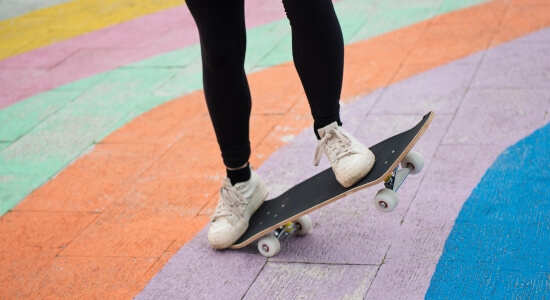Turning on a skateboard is not just about changing your direction while riding; it’s also about maintaining control, stability, and safety. Mastering turning techniques will enable you to navigate various terrains, ride more smoothly, and avoid potential obstacles.
We’re here to arm you with the knowledge and techniques to execute those perfect turns on your skateboard. Whether you’re just starting your skateboarding journey or a seasoned rider looking to enhance your skills, this guide will be your trusty companion in mastering the art of turning. So, get ready to unlock the secrets of precise and controlled turns, and let’s carve our way into the heart of skateboarding excellence together.
Pre-requisite of Learning How to Turn Skateboard
Before diving into the specifics of turning, you must ensure you are comfortable with fundamental skateboarding skills such as maintaining balance on the board, propelling yourself forward, riding in a straight line, and coming to a stop. These foundational skills will provide the necessary groundwork to progress to more advanced turning techniques.
One pivotal aspect of turning on a skateboard is adjusting your skateboard truck. These components play a vital role in your ability to turn effectively. If your trucks are too tight, tilting your board becomes challenging, while overly loose trucks may make your board feel unstable. Striking the right balance is key; your trucks offer stability without hindering your turning ability.
How to Turn a Skateboard
When it comes to practicing your turns, start slow. Initiating your practice at a lower speed will provide a better understanding of shifting your weight correctly, enhancing your control over the board. Two primary techniques for turning on a skateboard are leaning (or carving) and kick-turns. Each method is suited for specific turning scenarios.
Leaning (Carving)

This technique is ideal for gentle, sweeping turns. Here’s a step-by-step guide on how to execute it:
- Position Your Feet: Place your feet over the board’s bolts for maximum stability and balance during the turn.
- Lean Into the Turn: Shift your weight towards the direction you wish to turn. To execute a left turn, lean back over your heels; lean forward over your toes for a right turn.
- Maintain Your Balance: It’s crucial to sustain your balance throughout the turn. If you sense yourself rocking, you may be leaning too forcefully. Strive to maintain an upright posture and slightly bend your knees to lower your center of gravity.
Kick-Turns

Kick-turns are invaluable for making sharp, abrupt turns. Here’s the process to master this technique:
- Position Your Feet: Place your front foot above the front trucks like the leaning technique. However, position your back foot on the skateboard’s tail to execute a kick-turn.
- Lift the Board: Apply gentle pressure to the skateboard’s tail to lift the front wheels off the ground.
- Turn the Board: Once the front wheels are off the ground, use your front foot to guide the board in your desired direction.
- Complete the Turn: Shift your weight back to your front foot to bring the front wheels back to the ground, thereby completing the turn.
As you progress in your skateboarding journey, you can explore more advanced turning techniques like power sliding and carving. Keep in mind that these methods demand more remarkable skills and are best learned under the guidance of a professional skateboard instructor.
Diversify your practice by tackling different terrains once you’ve mastered the basics at a slower pace. Each terrain presents challenges, allowing you to refine your turning skills and adapt to various conditions.
Safety should always be a top priority when skateboarding.
Always Wear Protective Gear: Make it a non-negotiable habit to wear protective gear, including a helmet, knee and elbow pads, and wrist guards, each time you step on your skateboard.
Skateboard in a Safe Environment: Choose a secure setting for your skateboarding practice, whether a designated skate park or an open, level area with no vehicular traffic.
Common Mistakes and How to Avoid Them
- Beginners often err by leaning excessively during turns, which can lead to a loss of balance and potential falls. Start with gentle leans and gradually increase the angle as your confidence grows.
- Proper foot positioning is crucial for stability during turns. Ensure your feet are correctly aligned over the board’s bolts before initiating a turn.
To enhance your turning skills, commit to regular practice. The more you practice, the more at ease and self-assured you will become on your skateboard. Additionally, observing other skateboarders and studying their techniques can provide valuable insights, allowing you to learn from their styles and approaches to turning.
Conclusion
Mastering the art of turning on a skateboard may require time and patience, but with the right approach and dedicated practice, you’ll soon execute smooth, precise turns. Always prioritize safety by wearing protective gear, maintaining your skateboard, and, most importantly, having fun!
Whether you’re a beginner or an experienced skateboarder aiming to enhance your turning abilities, this guide offers all the essential information you need. It’s time to hit the pavement and hone your turning skills. Happy skating!
